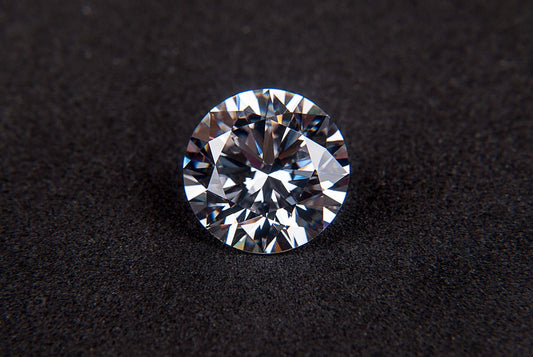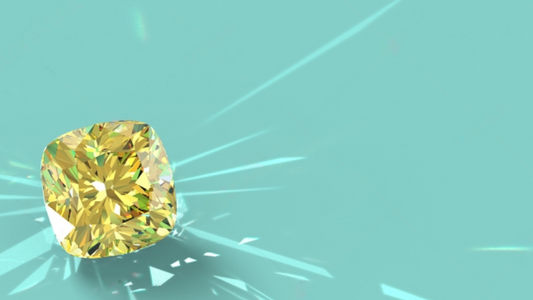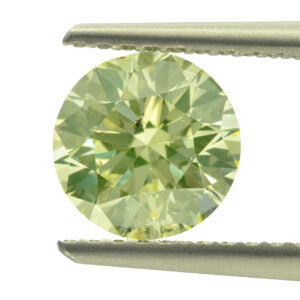The cut of a diamond is arguably the most important factor when it comes to whether or not the diamond looks bigger. The cut of a diamond refers to the proportions, symmetry and polish of the stone. Cut does not refer to shape or size. For example, you can have a round brilliant cut with an elongated shape (like Princess Diana's engagement ring), and it will still look bigger than a cushion cut.
A diamond's cut is also critical to its overall beauty and value. The quality of a diamond's cut is judged by how well the stone has been proportioned and how successfully it has been faceted. A diamond that has been expertly cut will reflect light brilliantly and sparkle with fire, while a poorly cut diamond may appear dark and dull.
When assessing the quality of a diamond's cut, Gemologists consider three factors: brightness, fire, and scintillation. Brightness refers to the overall light that is reflected from a diamond, while fire refers to the rainbow of colours that are seen when light enters and exits the stone. Scintillation is the sparkle or flash that is seen when a diamond moves.
Diamond Shapes: Which One Looks the Biggest?
Round Cut
One of the best choices is a round cut, which is a timeless and popular design. Despite its small size, it appears quite large due to its intense brilliance. In comparison to some of the other shapes we've mentioned, round diamonds do not appear as large. The shapes we'll discuss below are considerably larger than these, however. Round-cut diamonds are definitely the way to go if you absolutely love them! They're gorgeous! You can, however, find better options if making the diamond look as large as possible is your goal. In addition, round cuts are more expensive than some not-so-popular shapes since they are in high demand.
Pear Shape
Whether you wear a Pear shape diamond or not, this shape makes a statement! The pear-shaped diamond is also known as the teardrop diamond because of its larger top surface. It looks somewhat larger than a round-cut diamond. Despite this, pear-shaped diamonds are prone to being fragile due to their pointed tips. Furthermore, it is quite difficult to find a good-cut Pear-shaped diamond. Therefore, ensure that the sides of the piece are symmetrical before purchasing. Don't buy from sites that aren't trusted!
Marquise-Cut
A Marquise diamond has pointed elongated ends, extending your finger's appearance and making it look slender. Marquise cuts are not as popular as other shapes, but they are the best choice for people who love modern and chic styles. To prevent the pointy ends from chipping, extra care will need to be taken. You can hit two birds with one stone by adding a halo layer around the diamond; it makes the diamond appear larger while protecting the ends from chipping.
Oval Cut

Emeralds, Pears, and Marquises appear larger than they actually are. Nevertheless, Oval-cut diamonds are a great option for those who still want something basic. The Oval cut diamond exhibits similar sparkle and brilliance to the Round diamond but is generally less expensive. This modest design looks larger due to its elongated table and also looks slimmer and more feminine because of its large elongated table.
Emerald Cut

It was invented to protect Emerald from chipping off due to its brittle nature, which led to the signature Emerald-cut being invented. The parallel facets of the table facet are later trimmed and truncated to create an octahedral structure, along with the flattened window-like table facet. Diamonds cut into Emerald shapes, which are elegant and elongated, were extremely popular in the 19th and early 20th centuries. Nevertheless, if you're looking for an old-fashioned style, Emerald is the right choice for you. There's something timeless, classic, and certainly big about them! An emerald-cut diamond may not shine as brightly as a brilliant-cut diamond.
Trillion Cut
The Trillion cut is another underrated diamond shape when it comes to buying a diamond that looks large. Trillion cuts also appear much larger than their carat size because they have shallow cuts and a large face-up area. As in Pear and Marquise cuts, the pointy end of a Trillion-cut diamond may chip off if not cared for properly because of its triangular shape.
Conclusion
If you're one of those people who think diamonds are nothing more than a waste of money, you couldn't be more wrong. Here's why you should know about diamonds.
First and foremost, diamonds are an excellent investment. They hold their value over time and can even appreciate in value if they're well-cared for. Additionally, diamonds are incredibly durable. With proper care, they can last a lifetime and even be passed down from generation to generation.
If you're in the market for a diamond, it's important to have knowledge about the different types of diamonds available. This knowledge can help you make an informed decision about which type of diamond is right for you. Here's a look at some of the things you should know about diamonds:
FAQS
Which diamond cut has the largest surface area?
There are many different ways to cut a diamond, each with its own unique benefits. When it comes to the surface area, the largest cut is the princess cut. This popular choice is known for its square or rectangular shape and its large amount of sparkle. It is also one of the most versatile cuts, as it can be used in a variety of settings and styles. If you're looking for a diamond with maximum surface area, the princess cut is the way to go.
How many carats is the average engagement ring?
The average engagement ring size is 1.5 carats. The size of the diamond depends on the preference of the bride-to-be, but it is recommended to stay within a range of 1 carat to 2.5 carats.
In most cases, a woman will wear her engagement ring on her right hand's ring finger, and it will be worn facing inward toward her palm. This way, it will not get in the way when she is doing chores or other activities with that hand.
What diamond shape makes fingers look thinner?
When it comes to choosing a diamond shape that will make fingers look thinner, there are a few options to consider. First, look at the length-to-width ratio of the diamond. A ratio of 1.5 or less will make fingers look longer and thinner. Another option is an emerald cut diamond, which has rectangular facets that create a lengthening effect. Finally, consider a marquise cut diamond, which is narrow at the top and bottom and creates an illusion of length. Whichever shape you choose, be sure to work with a qualified jeweller to find the best cut and setting for your finger shape and size.











